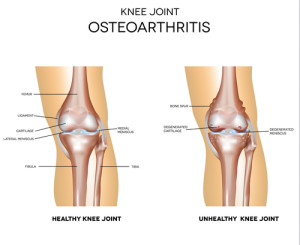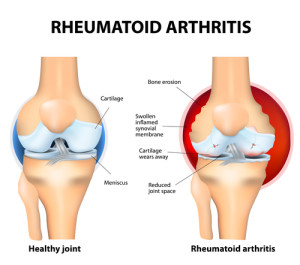Arthritis is a very common health problem I see as a rehabilitation trainer every week and one that affects millions of people all over the world. It can be extremely painful and significantly change your lifestyle and overall health. Most people think of this as an “old person’s” condition but it can affect many younger people and cause serious damage to their body. I myself was diagnosed with severe osteoarthritis in my left knee at the age of only 26 after many repeated injuries from sports and a lack of understanding with regard to strength and stability training, as well as recognizing the damage a poor diet has on joints. More on this later.
Arthritis is divided into two primary types: osteoarthritis, the wear-and-tear form of arthritis, and rheumatoid arthritis. They are completely different, even though they appear to be the same with symptoms of joint stiffness, pain, inflammation and swelling. Many people make the mistake of thinking there is nothing they can do about it and resort to a lifetime of anti-inflammatory medication. Having a better understanding as to what your condition is will help identify what action you can take and try to deal with the condition at the root cause instead of treating symptoms.
The two primary types of arthritis are:
Osteoarthritis – Degenerative joint disease usually affects the distal joints, or the joints at the end of your fingers and toes, not the middle ones. You typically may have it on just one joint, or on one hand or foot and not the other. I myself had issues with my left knee and right wrist and right big toe at different times before getting on top of my problems.
Rheumatoid arthritis –is a lot more severe and is an autoimmune disease that causes your body to break itself down. It tends to affect both sides of the body and is associated with joint deformities, especially your hands and fingers. It can be very crippling, and people can die from rheumatoid arthritis! A much more difficult condition to treat, but therestill is things you can do apart from medication to help relieve the severity.
What Can You Do To Treat This Condition?
Let’s look at the two cases separately as they are a lot different.
 Firstly, exercise can be extremely beneficial for Osteoarthritis and in fact I would say mandatory. As I mentioned in the beginning of this article, I was diagnosed with severe osteoarthritis at the age of only 26 and was told I had the knee of a 65 year old lady! And, I was told that I would need an operation soon and to stop all running and sports plus be very careful about weight bearing exercises as this could really do damage to the joint. I was prescribed a heavy dose of anti-inflammatory medication and told to rest my knee, do some stretches and take some glucosamine! While that seemed to settle the pain down a bit, the minute I stopped taking the anti-inflammatory my knee would swell up, becoming stiff and sore again. I was a bit concerned about relying on this as my solution as I knew that regular chronic use of these types of medications are associated with significant, and very serious, side effects such as kidney and/or liver damage. I knew there had to be a better solution and decided that I should try to strengthen the knee with some corrective exercise and see how that goes. Within months of adopting this approach I instantly saw a difference in the increased mobility and lack of stiffness that I had been suffering with for quite a while. Even though I had been playing sports and running a lot, I never had completed any form of structured strength training, and could now see the massive benefits of adopting this into my life. I am now 41 years old and since that diagnosis I have completed 5 half marathons, won several running races of 5km and 10km, competed in Triathlons, played basketball at a high level and can squat over 120kg in the gym! When I first started in the gym I could hardly squat my own bodyweight correctly let alone add weight.
Firstly, exercise can be extremely beneficial for Osteoarthritis and in fact I would say mandatory. As I mentioned in the beginning of this article, I was diagnosed with severe osteoarthritis at the age of only 26 and was told I had the knee of a 65 year old lady! And, I was told that I would need an operation soon and to stop all running and sports plus be very careful about weight bearing exercises as this could really do damage to the joint. I was prescribed a heavy dose of anti-inflammatory medication and told to rest my knee, do some stretches and take some glucosamine! While that seemed to settle the pain down a bit, the minute I stopped taking the anti-inflammatory my knee would swell up, becoming stiff and sore again. I was a bit concerned about relying on this as my solution as I knew that regular chronic use of these types of medications are associated with significant, and very serious, side effects such as kidney and/or liver damage. I knew there had to be a better solution and decided that I should try to strengthen the knee with some corrective exercise and see how that goes. Within months of adopting this approach I instantly saw a difference in the increased mobility and lack of stiffness that I had been suffering with for quite a while. Even though I had been playing sports and running a lot, I never had completed any form of structured strength training, and could now see the massive benefits of adopting this into my life. I am now 41 years old and since that diagnosis I have completed 5 half marathons, won several running races of 5km and 10km, competed in Triathlons, played basketball at a high level and can squat over 120kg in the gym! When I first started in the gym I could hardly squat my own bodyweight correctly let alone add weight.
My problem was not from getting old, or from genetics, or bad luck. It was from two areas. Firstly, the lack of overall functional strength and secondly, I was eating way too much sugar and fruits which I will explain shortly. The main point is that I only had good success when I addressed the “real” cause of my problem.
But what about if you are older, let’s say 75 years of age? Well funny enough, these people need it more than me! Peak bone mass is reached at around 25 years of age and remains relatively stable until around the age of 50. After the age of 50, progressive loss of bone mineral density begins to occur. As bones lose their density they become weaker and the risk of fracture during regular activities increases and this is also when arthritic problems can begin to take place. There have been countless studies and research that have proven the capability of people as old as 100 years to build muscle through high-intensity resistance training. Strength training is essential for not only preventing arthritic problems but improving overall movement function and avoiding disability. In my studio I actually train classes with over 50 older adults aged between 70-85 years of age! And ALL of them have reduced their stiffness and arthritic symptoms over time. Some even claim they have rid themselves of pain in their joints. Unfortunately many people are misinformed and believe that they are too old to go the gym and are even told so by many of the so called experts so they instead rely on glucosamine or anti-inflammatory medication to simply treat their symptoms.
I am calling out to people to try strength training and see what a difference it will make to your life.
 As for Rheumatoid arthritis, this is a lot more difficult to use the strength training approach. Aggressive medications and use of acupuncture and Vitamin D supplements are common for treating this condition. Exercise can be very difficult to do but not impossible. Gripping weights or cables I have found can be a real problem, and bodyweight exercises even harder. A very careful and well thought out approach is needed. Yet even with all these limitations, the people I have worked with, and who have this condition and attempt to do what they can, are ALWAYS better than those who do nothing.
As for Rheumatoid arthritis, this is a lot more difficult to use the strength training approach. Aggressive medications and use of acupuncture and Vitamin D supplements are common for treating this condition. Exercise can be very difficult to do but not impossible. Gripping weights or cables I have found can be a real problem, and bodyweight exercises even harder. A very careful and well thought out approach is needed. Yet even with all these limitations, the people I have worked with, and who have this condition and attempt to do what they can, are ALWAYS better than those who do nothing.
The one area that both types of arthritis must focus heavily on that requires little physical ability, is making sure the body gets the best quality nutrition.
You must eliminate sugar and fructose from your food. A diet high in sugar can present your body with arthritic symptoms. I know this is true as it happened to me with regards to my big toe and wrist. Before I mentioned that my knee improved from strength training yet I was developing a very sore wrist and big toe. This, as I was to find out, was more of a problem linked to me eating way too much sugar. Remember how I previously mentioned that I was doing a lot of running and triathlons? Well that sort of training led me to eating too many high sugar foods and sports drinks which over time led me to develop these gout or arthritic problems. Once I focused on cleaning up my nutrition and eliminating sugar and fructose, my symptoms disappeared instantly! Make no mistake about it, sugar will make you fat and has been linked to all types of chronic diseases and will eventually cause problems to your joints just like it did to me.
Getting a great source of fats and vitamins is critical. A diet rich in vegetables and omega 3 fats will do wonders for your body. Omega 3 is lacking considerably in modern foods and can be one of the best treatments you can use. It is an essential component that your body needs to reduce inflammation.I suggest using a good quality omega 3 supplement such as flax meal or krill oil.
Conclusion
I hope this article educates the community that the benefits of strength training is real, in particular for older adults. Ignoring the dangers of lack of muscle, fructose, sugar and poor omega 3 fats in your diet could be the reason why you are getting the aching joints, not that you are getting old.
Nick Jack is owner of No Regrets Personal Training a Rehabilitation & Sports Training Studio located in Melbourne Australia. Having worked as a Trainer for over 10 years and has qualifications as a CHEK Exercise Coach, CHEK Golf Performance Specialist & Twist Conditioning Sports Conditioning coach he specializes in working with rehabilitation and injury prevention programs. You can check out his website at www.noregretspt.com.au

